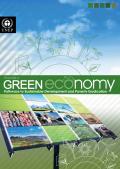
The Green Economy Report is compiled by UNEP’s Green Economy Initiative in collaboration with economists and experts worldwide. It demonstrates that the greening of economies is not generally a drag on growth but rather a new engine of growth; that it is a net generator of decent jobs, and that it is also a vital strategy for the elimination of persistent poverty. The report also seeks to motivate policy makers to create the enabling conditions for increased investments in a transition to a green economy.
The report includes chapters on the following areas:
- Agriculture
- Fisheries
- Water
- Forests
- Renewable Energy
- Manufacturing
- Waste
- Buildings
- Transport
- Tourism
- Cities
- Modelling
- Finance
This report - which contains case studies of Melbourne, Vancouver, Paris, Toyama and Portland - offers a comprehensive understanding of the compact city concept, its role in today’s urban contexts, and the potential outcomes of compact city policies. It examines compact city policies across the OECD in relation to green growth objectives and the role of indicators in tracking policy performance. The report proposes compact city strategies and ideas for achieving better outcomes and highlights governance challenges for implementing practical compact city strategies. Importantly, it highlights how urban spatial policies can help foster economic growth and development while preventing environmental degradation and climate change. The report thus addresses a central concern of the OECD Green Growth Strategy, and provides an important contribution to it.
Flood exposure is increasing in coastal cities owing to growing populations and assets, the changing climate, and subsidence. This article provides a quantification of present and future flood losses in the 136 largest coastal cities. Using a new database of urban protection and different assumptions on adaptation, we account for existing and future flood defences. Average global flood losses in 2005 are estimated to be approximately US$ 6 billion per year, increasing to US$ 52 billion by 2050 with projected socio-economic change alone. With climate change and subsidence, present protection will need to be upgraded to avoid unacceptable losses of US$ 1 trillion or more per year. Even if adaptation investments maintain constant flood probability, subsidence and sea-level rise will increase global flood losses to US$ 60–63 billion per year in 2050. To maintain present flood risk, adaptation will need to reduce flood probabilities below present values. In this case, the magnitude of losses when floods do occur would increase, often by more than 50 per cent, making it critical to also prepare for larger disasters than we experience today.
The book includes case studies from Hannover (Germany), Auckland (New Zealand), Flanders (Belgium), Western Canada, City of Raleigh (United States), and Kyoto (Japan).
Bringing together 35 contributions from over 60 experts from research, the private sector, international organisations and local governments worldwide, ICLEI’s compendium bridges the gap between the global promotion of the concept and its actual realisation on the ground by illustrating the advantages of the Green Urban Economy approach with concrete and practical examples.
By embedding both economic and environmental concerns in policymaking, the compendium calls for smarter approaches and innovation in applying existing tools and new methods towards achieving sustainable urban development. Covering issues such as governance, economics, new business models, green jobs, technology, infrastructure, urban poverty, it is also an acknowledgement of and call for more locally responsive actions, new thinking and research.
The book includes case studies from Hannover (Germany), Auckland (New Zealand), Flanders (Belgium), Western Canada, City of Raleigh (United States), and Kyoto (Japan).
This report synthesises the findings from six case studies of urban green growth policies, four at city level (Paris, Chicago, Stockholm, Kitakyushu) and two at the national level (China, Korea). It offers a definition of urban green growth and a framework for analysing how it might play out in different types of cities. It demonstrates the importance of urban policies for achieving national environmental policy goals and discusses the increased efficiency of policy intervention at the urban level. It identifies urban activities to reduce environmental impact that are most likely to contribute to the policy priorities of job creation, urban attractiveness, metro-regional supply of green products and services, and increased urban land values. It also provides guidance on addressing potential financing and governance challenges that may arise in pursuing urban green growth. Finally, the report offers a preliminary proposal for how green growth in cities could be measured.
